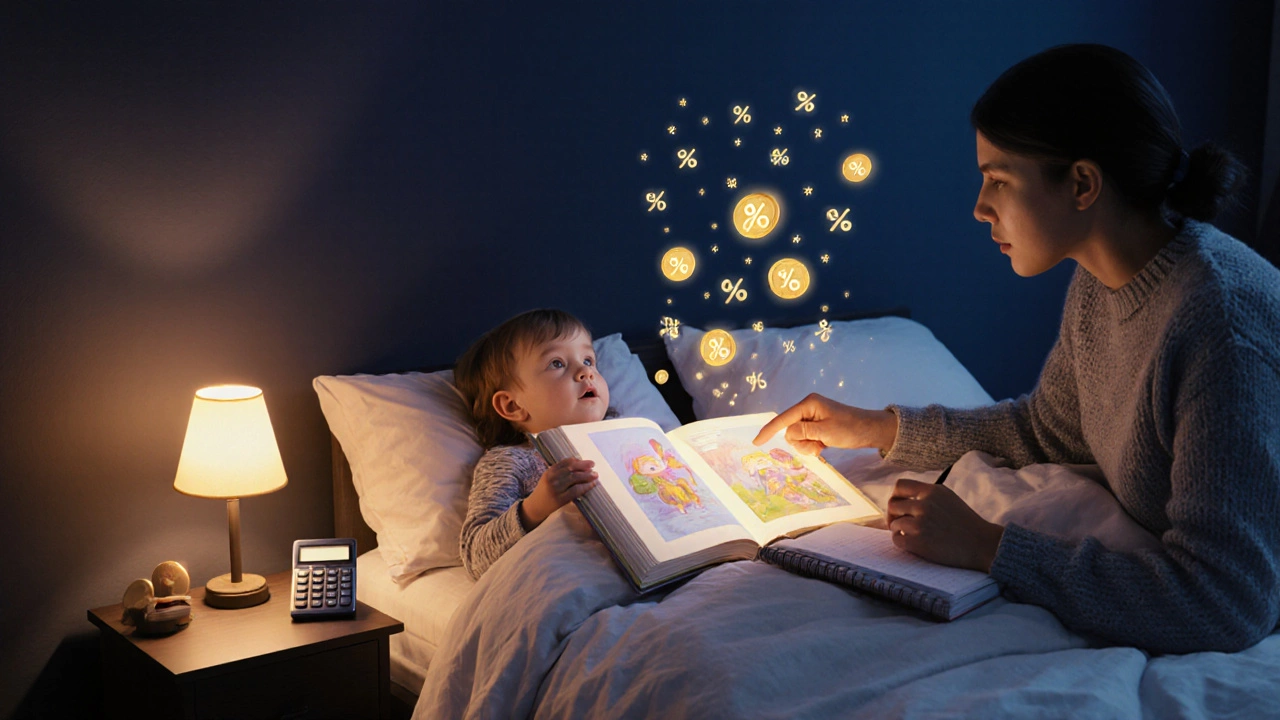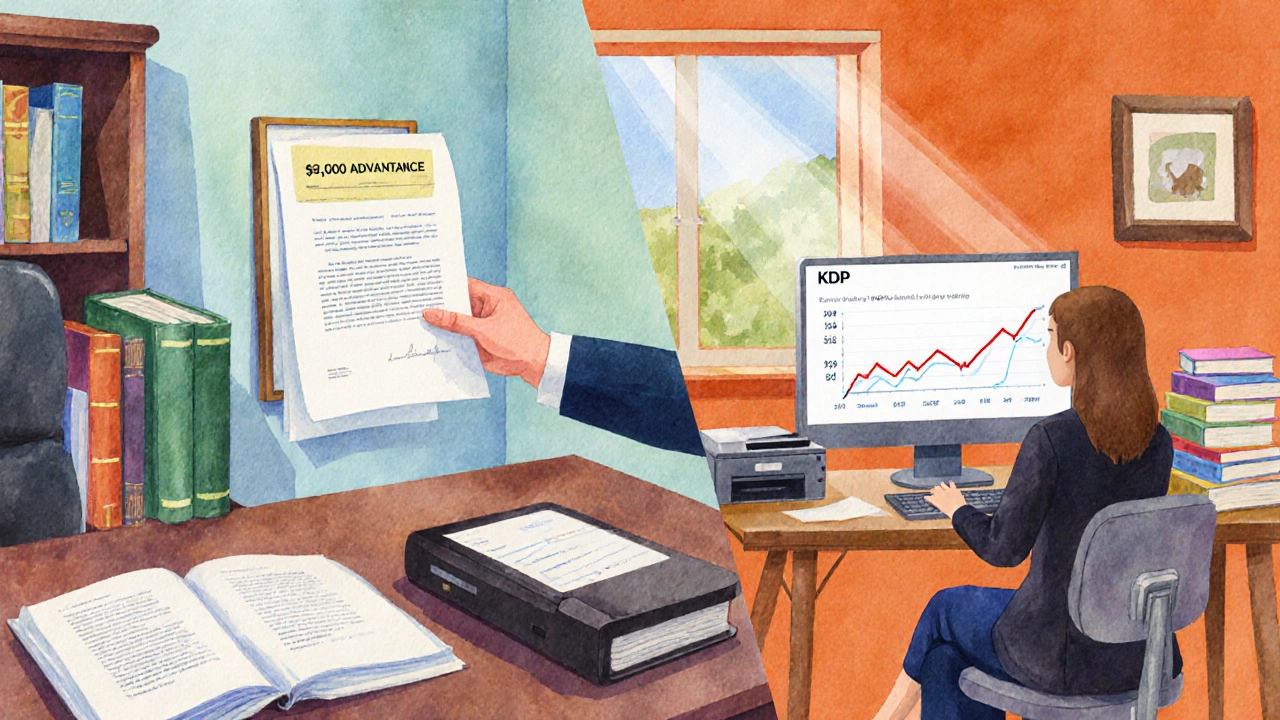Children's Book Earnings: How Much Can You Make?

Children's Book Earnings Calculator
Estimated Earnings
Enter details and click Calculate
Royalty Rate: -
Net Price per Unit: -
Total Earnings: -
This calculator helps estimate potential earnings from children's books based on:
- Book Type: Different age groups have varying pricing and royalty structures
- Publishing Method: Traditional vs. self-publishing affects royalty rates and upfront costs
- List Price: Influences the net price and royalty calculations
- Sales Volume: Directly impacts total earnings
For traditional publishing, royalties are typically 5-10% of the net price for print books and 25-30% for ebooks. For self-publishing, authors retain 60-70% of net price for print and 40-70% for ebooks.
Quick Takeaways
- Traditional publishers usually offer a $1,000‑$10,000 advance; self‑publishers keep 60‑70% of each sale.
- Royalty rates range from 5‑10% of list price (print) to 40‑70% of net price (ebook).
- A well‑marketed picture book can earn $5,000‑$20,000 in the first year; series can push six‑figures.
- Illustrations, marketing spend, and distribution channel are the biggest income drivers.
- Setting realistic goals and tracking numbers with a simple spreadsheet can prevent surprise shortfalls.
Thinking about turning a bedtime story into a paycheck? The numbers can feel murky, but they become clear once you break down the two main routes - traditional publishing and self‑publishing - and look at the actual royalty formulas that most contracts use.
Children's books are a distinct market segment that blends storytelling, illustration, and education. They typically fall into three age brackets: board books (0‑3), picture books (3‑8) and early readers (6‑10). Each bracket has its own pricing, production cost, and sales pattern, which directly affect how much money an author can earn.
Two Publishing Paths: Traditional vs. Self‑Publishing
Before the money talks start, you need to decide who’s handling the heavy lifting. Below is a snapshot of the main differences.
| Aspect | Traditional Publisher | Self‑Publisher |
|---|---|---|
| Advance | $1,000‑$10,000 (sometimes higher for established authors) | None - you fund production yourself |
| Royalty Rate (Print) | 5‑10% of list price | 60‑70% of net price (after printing cost) |
| Royalty Rate (eBook) | 25‑30% of net price | 40‑70% of net price |
| Up‑front Costs | Publisher covers editing, illustration, printing, distribution | Author pays for editing, illustration, ISBN, cover design, printing |
| Control | Publisher decides cover, price, marketing budget | Author decides everything, from layout to pricing |
| Time to Market | 12‑24 months on average | Weeks to months, depending on preparation |
Both routes can be lucrative, but the risk‑reward balance shifts. Traditional publishing offers a safety net - you get an advance and the publisher shoulders most production costs. Self‑publishing demands upfront cash, but you keep a far larger slice of each sale.

How children's book royalties Are Calculated
At the core of any earnings discussion is the royalty formula. Most contracts follow this simple pattern:
- Determine the royalty rate (e.g., 7% of list price for a print book).
- Apply the rate to the net price the retailer pays the publisher (list price minus discount).
- Subtract any applicable taxes or deductions.
For a $12.99 picture book with a 10% retailer discount, the net price is $11.69. At a 7% royalty, the author earns about $0.82 per copy sold.
Self‑published eBooks use a different base: the net price after the platform’s printing or distribution fee. On Amazon KDP, a 70% royalty on a $4.99 eBook after a $0.15 delivery cost yields roughly $3.34 per sale.
Real‑World Earnings Scenarios
Numbers become clearer when you see them in action. Below are three common cases, based on data from the Authors Guild, Publisher's Weekly, and indie author surveys up to 2024.
- Case A - Traditional debut picture book. Advance: $5,000. Royalty: 7% of net price. First‑year sales: 8,000 copies. Earnings: $5,000 advance + (8,000×$0.80) ≈ $11,400.
- Case B - Self‑published picture book via KDP Print. Production cost per unit: $2.50. List price: $14.99. Net price after Amazon’s 40% cut: $8.99. Royalty (70% of net): $6.29 per copy. First‑year sales: 2,500 copies. Earnings: 2,500×$6.29 ≈ $15,725, minus $6,250 printing cost = $9,475 profit.
- Case C - Series of five early readers, self‑published as eBooks. Average price: $3.99. Platform royalty: 70% after $0.15 delivery. Net per sale: $3.84×0.70 ≈ $2.69. Total sales across series: 30,000 copies. Gross earnings: 30,000×$2.69 ≈ $80,700. Subtract editing, illustration, and marketing (~$15,000) → net profit ≈ $65,700.
Notice how the series model scales dramatically. Even modest per‑book earnings multiply when you have multiple titles that share characters, branding, and an existing fan base.
Key Factors That Influence Income
Every author’s situation is unique, but five variables regularly swing the earnings curve.
- Illustration quality: A captivating illustrator can boost sales 30‑50% for picture books.
- Marketing budget: Authors who spend at least 10% of their projected gross on ads (Amazon, Facebook, BookBub) often double their sales.
- Distribution channel: Wide distribution (Barnes & Noble, libraries) adds retail orders that add 20‑40% to print sales.
- Pricing strategy: Keeping picture books between $12‑$16 maximizes perceived value while staying affordable for parents.
- Series potential: A single successful character can spawn sequels, merchandise, and foreign rights deals, each adding 5‑15% royalty streams.
Checklist: Maximize Your Children’s Book Income
- Research and hire a professional illustrator; request a sample before committing.
- Secure an ISBN (ISBN) for every format - print, ebook, audiobook.
- Write a compelling book description and choose keywords that parents actually search for (e.g., "bedtime stories for 4‑year‑olds").
- Set up pre‑launch email list; offer a free PDF chapter to collect leads.
- Allocate at least 10% of projected revenue to targeted ads during launch week.
- Consider enrolling in a print‑on‑demand service (KDP Print or IngramSpark) for wider shelf presence.
- Track sales weekly in a spreadsheet: columns for units sold, royalty per unit, total earned, and marketing spend.
- Explore foreign rights licensing after you have a solid US sales record - many authors earn extra 5‑12% per language.
Frequently Asked Questions
What is a typical advance for a first‑time children's author?
Most debut picture‑book authors receive between $1,000 and $5,000. A few mid‑list publishers may offer up to $10,000 if the manuscript shows strong market potential.
Can I earn more from eBooks than from print?
Yes, especially with self‑publishing platforms that pay 70% royalties. However, print sales often bring higher absolute dollars per unit, and many parents still prefer physical books for kids.
Do I need an agent to get a traditional deal?
Agents dramatically improve your chances, especially with the big houses that rarely accept unsolicited submissions. They also negotiate better royalty clauses.
How long does it take to see money after a book launch?
Traditional royalties are paid semi‑annually and only after the advance is earned back. Self‑published authors receive royalties within 60 days of each sale, so cash flow can start almost immediately.
Is it worth spending money on a professional illustrator?
For picture books, absolutely. A strong visual style can double or triple sales, making the illustration budget one of the smartest investments you can make.